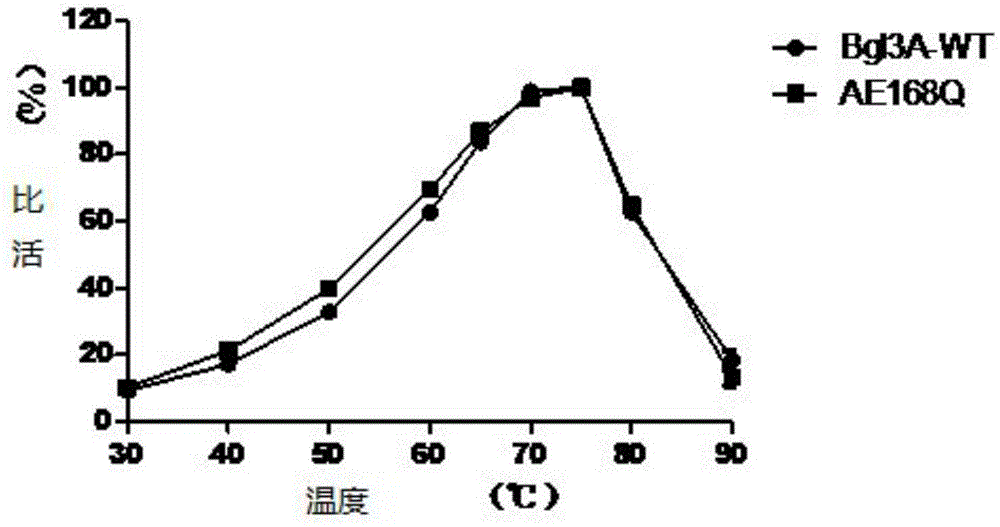Beta-glucosaccharase improved mutant E168Q as well as coding gene and applications thereof
A technology of glucosidase and mutants, which is applied in the field of genetic engineering and genetic engineering, and can solve problems such as high cost
- Summary
- Abstract
- Description
- Claims
- Application Information
AI Technical Summary
Problems solved by technology
Method used
Image
Examples
Embodiment 1
[0034] Cloning of embodiment 1 high catalytic efficiency β-glucosidase mutant coding gene A-E168Q
[0035] The present invention uses the acid β-glucosidase (its amino acid sequence as SEQ ID NO.3) derived from the thermophilic fungus Talaromycesleycettanus JCM12802 as the parent, and uses molecular biology techniques to replace the sequence of the acid β-glucosidase and then express it .
[0036] SEQ ID NO.3 is as follows:
[0037] YGFGGSGWDAAYGRAKAALNKLNQTEKVGIVTGVKWMGGPCVGNTYKPSSIDYPSLCLQDSPLGVRFANPVTAFPAGINAGATWDRSLINARGAAMGAEAKGLGVNVQLGPVAGPLGKNPNSGRIWEGFSNDPYLSGVAMEETIAGMQGSGVQACAKHYIGNEQEHNRETISSNIDDRTLHELYVWPFMNAVKANVASVMCSYNEVNGSWSCENDALLNGLLKTELGFPGYIMSDWNAQHTTVNSANSGLDMTMPGSDFNNPPGSIYWGPNLEAAVANGSVPQSRLDDMVTRILASWYLVGQDEGYPPVAFSSWNGGKANVDVTGDHKSVVRAVARDSIVLLKNDNNALPLRKPKSLAIIGQDATVNPAGPNACSDRGCDTGTLAMGWGSGTAQFPYIVGPLDAIQSQAAADGTNITTSTTDDTTAAASAAASAGTAIVFINSDSGEGYITVEGNAGDRNNLDPWHNGNELVQAVAAVNKNVIVVVHSVGPVILEAILAQPNVKAIVWPGLPGQESGNALVDVLYGSTSPSGKLPYTIAKQFSDYGTTWTTSLV...
Embodiment 2
[0041] Example 2 Preparation of β-glucosidase mutants with high catalytic efficiency.
[0042] The expression vector pPIC9r was double digested (EcoRI+NotI), and the gene A-E168Q encoding the high catalytic efficiency β-glucosidase mutant was double digested (EcoRI+NotI). The gene fragment of the -glucosidase mutant was connected with the expression vector pPIC9r to obtain the recombinant plasmid pPIC9r-A-E168Q containing the high catalytic efficiency β-glucosidase mutant gene A-E168Q and transformed into Pichia pastoris GS115 to obtain the recombinant yeast strain GS115 / A-E168Q.
[0043] Take the GS115 strain containing the recombinant plasmid, inoculate it in a 1L Erlenmeyer flask with 300mL of BMGY medium, place it at 30°C, and culture it on a shaker at 220rpm for 48h; then centrifuge the culture solution at 3000g for 5min, discard the supernatant, and use 100mL of 0.5% methanol for precipitation. The BMMY medium was resuspended, and placed again at 30°C, 220rpm to induce ...
Embodiment 3
[0045] Example 3 Activity Analysis of Recombinant High Catalytic Efficiency β-Glucosidase Mutant and Wild Type
[0046] Determination of β-glucosidase activity: the amount of the product p-nitrophenol (pNP) generated by enzymatic hydrolysis of the substrate pNPG was measured at 405 nm.
[0047] Reaction steps: Mix 125 μl 2mM pNPG substrate with 125 μl buffer, add 250 μl appropriately diluted enzyme solution, react at 75°C for 10 min, add 1.5 mL 1M Na 2 CO 3 Terminate the reaction and measure the OD using a spectrophotometer 405 value.
[0048] Definition of enzyme activity unit: 1 β-glucosidase activity unit (U) is defined as the amount of enzyme required to decompose the substrate pNPG to generate 1 μmol p-nitrophenol (pNP) per minute under given reaction conditions.
PUM
 Login to View More
Login to View More Abstract
Description
Claims
Application Information
 Login to View More
Login to View More - R&D
- Intellectual Property
- Life Sciences
- Materials
- Tech Scout
- Unparalleled Data Quality
- Higher Quality Content
- 60% Fewer Hallucinations
Browse by: Latest US Patents, China's latest patents, Technical Efficacy Thesaurus, Application Domain, Technology Topic, Popular Technical Reports.
© 2025 PatSnap. All rights reserved.Legal|Privacy policy|Modern Slavery Act Transparency Statement|Sitemap|About US| Contact US: help@patsnap.com



